Introduction
If you drop a little pebble in a pond of still water, the water surface gets disturbed. The disturbance does not remain confined to one place, but propagates outward along a circle. If you continue dropping pebbles in the pond, you see circles rapidly moving outward from the point where the water surface is disturbed. It gives a feeling as if the water is moving outward from the point of disturbance. If you put some cork pieces on the disturbed surface, it is seen that the cork pieces move up and down but do not move away from the centre of disturbance.
This shows that the water mass does not flow outward with the circles, but rather a moving disturbance is created. These patterns, which move without the actual physical transfer or flow of matter as a whole, are called waves.
For example: Consider a boy holding a thread and one end of thread is tied to the wall. When a boy moves the thread, the thread moves in the form of a wave.
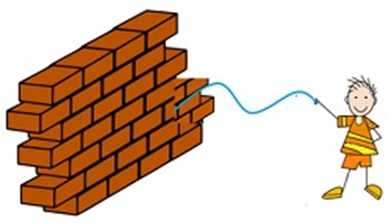
In this Chapter, we will study such waves. In this chapter we will see the importance of waves in our life.
We will also study about the different properties of waves, some terms related to waves and also about different types of waves. We will also learn how waves propagate.
Waves
A wave is a kind of distribution due to repeated vibrations of particles from a normal or equilibrium condition, propagating without the transport of matter. In general a wave transports both energy and momentum. Waves transport energy and the pattern of distribution has information that propagates from one point to another.
For example: Consider the sound of the horn; this sound reaches our ear because of sound waves. There is transfer of energy from one point to another with the help of particles in the medium.
- These particles don’t move, they just move around their mean position, but the energy is getting transferred from one particle to another and it keeps on transferring till it reaches the destination.
- The movement of a particle is initiated by the disturbance. And this disturbance is transferred from one point to another through space and time.
Note:-Energy and not the matter is transferred from one point to another.
Types of Waves
- Mechanical waves
- Electromagnetic waves
- Matter waves
Mechanical waves: - The mechanical waves are governed by all of Newton’s laws of motion. Medium is needed for propagation of the wave. For Example: - Water Waves, Sound Waves
Electromagnetic waves: - Electromagnetic waves are related to electric and magnetic fields. An electromagnetic wave does not need a medium to propagate, it carries no mass, does carry energy. Examples: - Satellite system, mobile phones, radio, music player, x-rays and microwave.

Matter waves: - Waves related to matter. Matter consists of small particles .Matter waves are associated with moving electrons, protons, neutrons & other fundamental particles etc. It is an abstract concept.
Types of wave motion
Depending on the relationship between the direction of oscillation of individual particles and wave propagation, the waves are classified in two categories. They are Transverse waves and longitudinal waves.
Transverse waves
The transverse waves are those in which the direction of disturbance or displacement in the medium is perpendicular to that of the propagation of the wave.
- The direction in which a wave propagates is perpendicular to the direction of disturbance.

For example: - Consider a man holding one end of a thread and the other end of the thread is fixed to the wall. When a little jerk is given to the thread in the upward direction. The entire thread moves in a wavy manner.
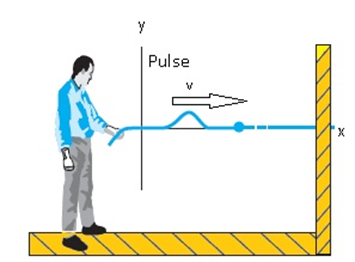
- The jerk propagated along the entire length of the thread.
- The small disturbance which came from the source at one end, that disturbance getting propagated and that is known as direction of propagation.
Disturbance is vertically upward and wave is horizontal. They are perpendicular to each other. This type of wave is known as transverse wave.
Conclusion: Transverse waves are those waves which propagate perpendicular to the direction of the disturbance. Direction of disturbance is the direction of motion of particles of the medium.
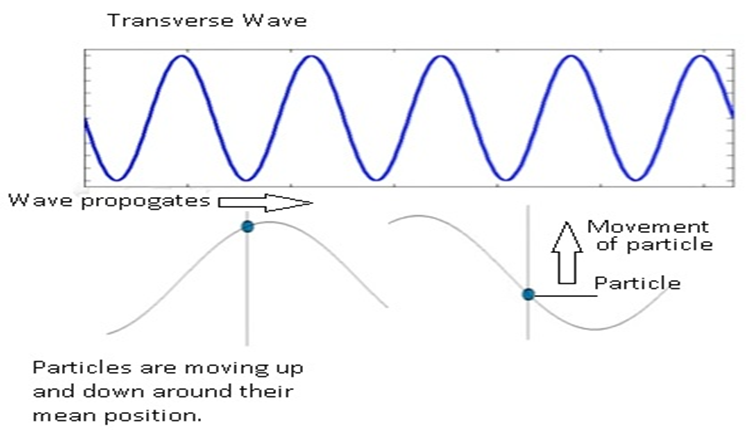
Longitudinal waves
The waves in which individual particles of the medium executes simple harmonic motion about their mean positions along the directions of propagation of the wave are called longitudinal waves.
For example: Waves in spring and sound waves etc.
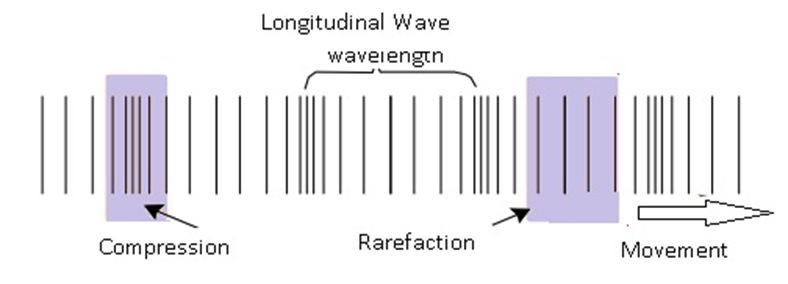
Longitudinal means something related to length. In longitudinal waves the direction of disturbance or displacement in the medium is along the propagation of the wave.
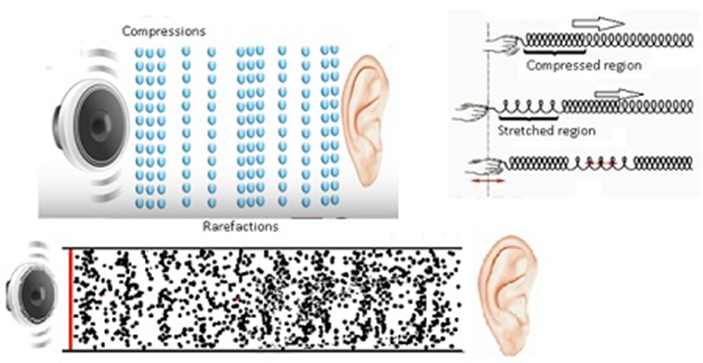
- In a Longitudinal wave there are regions where particles are very close to each other. These regions are known as compressions.
- In some regions the particles are far apart. Those regions are known as rarefactions.
Displacement of progressive waves
Amplitude and phase together describe the complete displacement of the wave. Displacement function is periodic in space and time.
Displacement of the particles in a medium takes place along the y-axis. Generally displacement is denoted as a function of X and T, but here it is denoted by y.
In case of transverse wave displacement is given as: y(x, t)
Where x=propagation of the wave along x-axis, and particles oscillate along y-axis.
Therefore y(x, t) = A sin (kx – ωt + φ)
This is the expression for displacement. This expression is the same as the displacement equation which is used in oscillatory motion.
As cosine function; y(x, t) = B cos (kx – ωt + φ),
As both sine and cosine function) y (x, t) = A sin (kx – ωt + φ) + B cos (kx – ωt + φ).
Mathematically:
- Wave travelling along +X-axis: y(x, t) = a sin (kx – ωt + φ).
As time t increases the value of x increases. This implies the x moves along the positive x-axis.
- Waves travelling along -X axis: y(x, t) = a sin (kx +ωt + φ).
As time t decreases the value of x decreases. This implies the x moves along (-) ive x-axis.

Amplitude and Phase of a wave Amplitude and phase together describes the position of the particle.
Amplitude is the maximum displacement of the elements of the medium from their equilibrium positions as waves pass through them. It is denoted by A.
- In Transverse waves the distance between the point P and Q (in the Figure) is maximum displacement. This maximum displacement of the particles is known as amplitude.
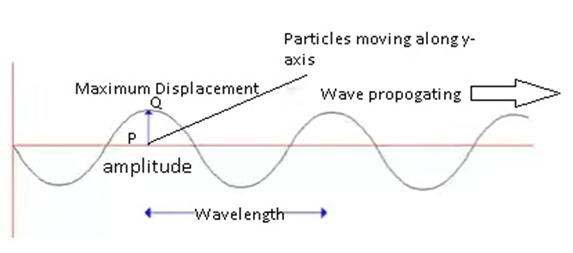
In Longitudinal waves In case of longitudinal waves the particles will not oscillate to a very large distance.
- Amplitude is the centre of two compressed regions. Because at the centre of the two compressed regions the particle is most free to displace to maximum displaced position.
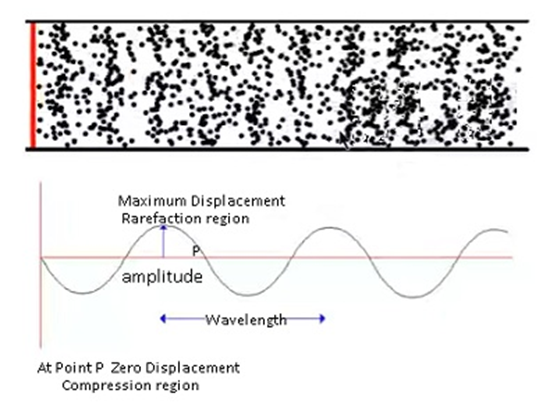
Phase: Phase of a wave describes the state of motion as the wave sweeps through an element at a particular position.
In-phase– Two points are said to be in-phase with each other when these two points are at the same position and they both are doing the same thing i.e. both the two points are exhibiting the same behaviour. Points C and F are in phase with each other.
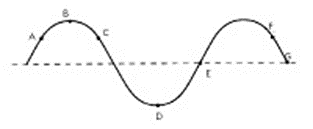
Out-of-phase –Two points are said to be out of phase even though they are at the same points but they are doing opposite things i.e. both the points are exhibiting the different behaviour.
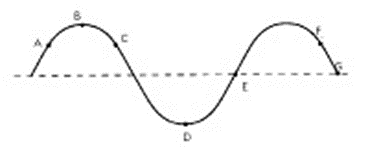
- Out of phase means which is not in phase.
- Points B and D,E and G are out of phase by 180 degree
Two waves can be completely in-phase or out of phase with each other. They can be partially in phase or out of phase with each other. Let’s try to understand the concept with help of an example
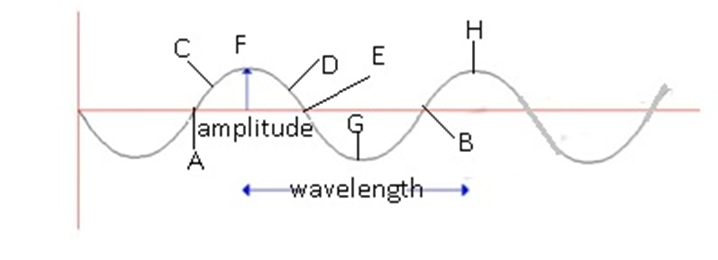
- Consider two points A and B on a wave. Their positions as well as their behaviour are the same. Therefore points A and B are in phase.
- Consider points A and C on a wave. They are not in phase with each other as their position is not the same.
- Similarly the points C and D are not in phase with each other as their positions are the same but the behaviour is different. Therefore they are not in phase with each other.
- Consider the points F and G. Their positions are the same but the behaviour is totally opposite. So F and G are out of phase.
- Consider the points F and H; they are in phase with each other as their position is the same as well as their behaviour.
Wavelength
Wavelength The term wavelength means length of the wave. Wavelength is defined as the minimum distance between two consecutive points in the same phase of wave motion. It is denoted by λ.
In case of transverse waves we use the term crest for the peak of the maximum displacement. The point of minimum displacement is known as trough.
In case of transverse wave wavelength is the distance between two consecutive crests or distance between two consecutive troughs.
In case of longitudinal waves, wavelength is the distance between the two compressions or the distance between the two rarefactions provided the compressions or rarefactions are nearest.
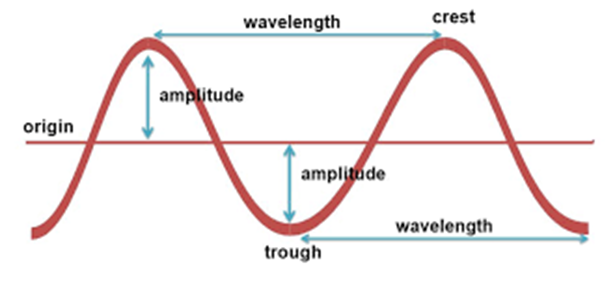
Wave Number
Wave number is the reciprocal of wavelength of a wave. It is defined as the number of waves per unit length. Since the unit of wavelength is a metre, the unit of wave number is the inverse of a metre.
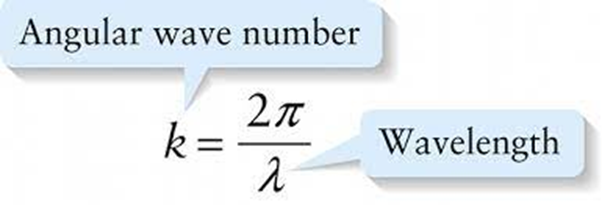
Time Period, Frequency and Angular frequency
- Time Period of a wave: - Time Period of a wave is the time taken through one complete oscillation. It is denoted by ’T’.
- Frequency of a wave: - Frequency of a wave is defined as the number of oscillations per unit time. It is denoted by f. f =1/T.
- Angular frequency: -Angular frequency is defined as the frequency of the wave in terms of a circular motion. The term angular frequency is used only when there is an angle involved in the motion in that particular motion .It is denoted by ‘ω’.
Travelling Waves Travelling waves are waves which travel from one medium to another. They are also known as progressive waves. Because they progress from one point to another.
- Both longitudinal and transverse waves can be travelling waves.
- Wave as a whole moves along one direction.
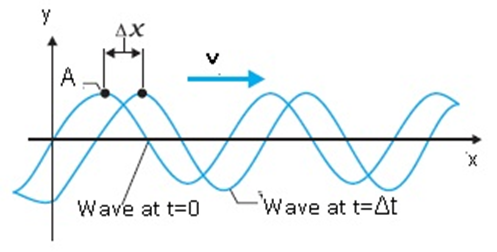
Speed of a transverse wave in a stretched string
Consider a stretched string and if given transverse disturbance on one end then the disturbance travels throughout the string. Thereby giving rise to transverse waves. The particles move up and down and the waves travel perpendicular to the oscillation of the particles.
Transverse wave speed determined by two factor which are:
- Mass per unit length- As mass gives rise to Kinetic energy. If no mass then no kinetic energy. Then there will be no velocity. It is denoted by μ.
- Tension-Tension is the key factor which makes the disturbance propagate along the string. Because of tension the disturbance travels throughout the wave. It is denoted by T.
Dimensional Analysis to show how the speed is related to mass per unit length and Tension
μ = [M]/ [L] …… (i)
T=F=ma =
Dividing equation (i) by (ii):-
![]()
Therefore ![]() , where C=dimensionless constant
, where C=dimensionless constant
Conclusion: velocity v depends on properties of the medium and not on frequency of the wave.
Speed of a longitudinal wave in a stretched string
Longitudinal wave speed determined by:
Density – Longitudinal waves are formed due to compressions (particles very close to each other) and rarefactions (particles are far from each other).
At certain places it is very dense and at certain places it is very less dense. So density plays a very important role. It is denoted by ρ.
Bulk modulus– Bulk modulus tells how the volume of a medium changes when the pressure on it changes.
If we change the pressure of compressions or rarefaction then the volume of the medium changes. It is denoted by B.
Dimensional Analysis to show how the speed is related to density and bulk modulus
ρ =mass/volume=
B = - (Change in pressure (ΔP))/Change in volume (ΔV/V))
ΔV/V is a dimensionless quantity as they are 2 similar quantities.
Dividing
We know that
![]()
Where C=dimensionless constant
In case of fluids: - v= C √ (B/ ρ)
In case of solids: - v= C √ (Y/ ρ)
The principle of superposition of waves
Principle of superposition of waves describes how the individual waveforms can be algebraically added to determine the net waveform.
Waveform tells about the overall motion of the wave. It does not tell about individual particles of the wave.
Suppose we have 2 waves and Example of superposition of waves is Reflection of waves.
Mathematically: -
Case1:- Consider 2 waves which are in phase with each other. They have the same amplitude, same angular frequency, and same angular wave number.
If wave 1 is represented by y1(x, t) =a sin (kx – ωt).
Wave 2 is also represented by y2(x, t) =a sin (kx – ωt).
By the principle of superposition
The resultant wave y(x t) = (2a sin (kx – ωt)) will also be in phase with both the individual waves but the amplitude of the resultant wave will be more.
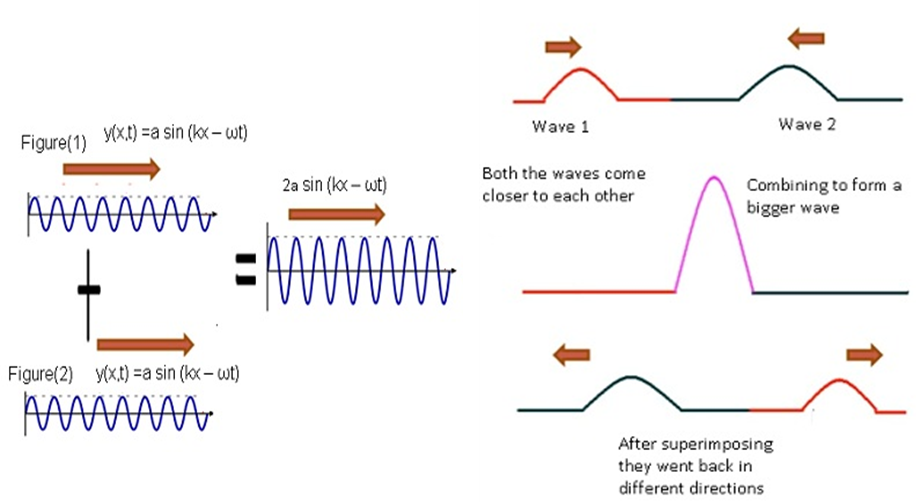
Case2:- Consider when the two waves are completely out of phase. φ = π
If wave 1 is represented by y1(x, t) =a sin (kx – ωt).
Wave 2 is represented by y2(x, t) =a sin (kx – ωt+ π).
Y2 =a sin (π-(-kx+ ωt) which gives y2=-a sin (kx- ωt)
Therefore by superposition principle y=y1+y2=0
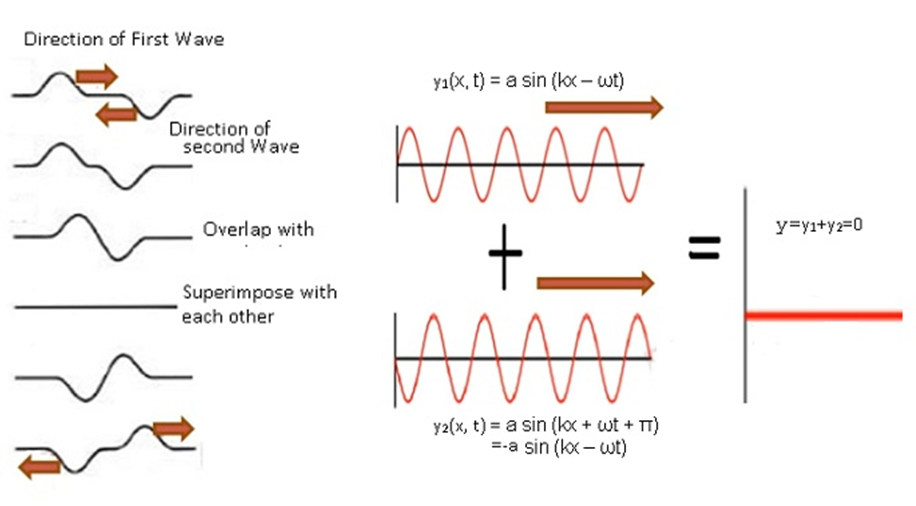
Case 3:- Consider when the two waves partially out of phase φ>0; φ<π
If wave 1 is represented by y1(x, t) =a sin (kx – ωt).
Wave 2 is represented by y2(x, t) =a sin (kx – ωt+ φ).
Therefore by the principle of superposition of waves,
y = y1+ y2 = a [sin (kx-ωt) +sin (kx – ωt+ φ]
y=2a cos (φ/2) sin (kx – ωt + (φ/2))
(By using the formula sinA +sinB=2sin (A+B)/2) cos (A-B)/2)
Amplitude = 2a cos (φ/2) and Phase will be determined by (φ/2).
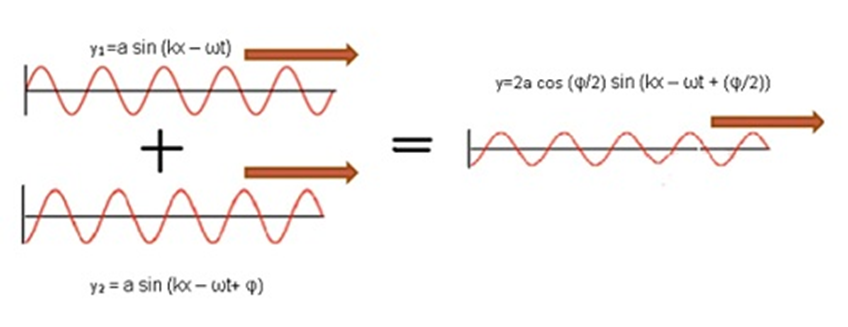

 Madhava Publications
Madhava Publications
